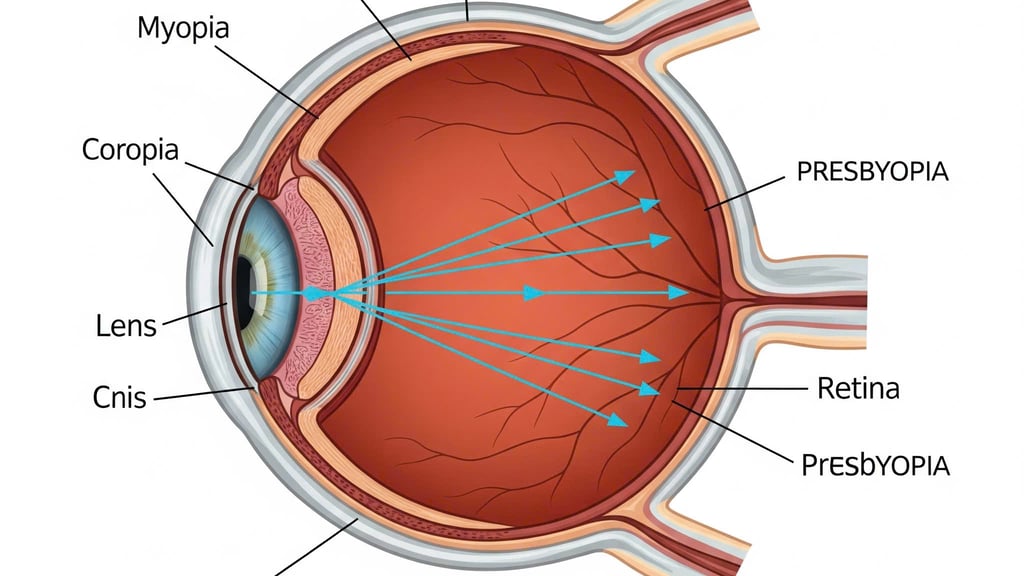Progressive myopia after the age of 30 - is it dangerous? - Can myopia and presbyopia occur together?
2/20/20257 min read


Introduction to Myopia and Its Progression
Myopia, commonly known as nearsightedness, is a refractive error where distant objects appear blurred while close ones can be seen clearly. This condition arises when the eyeball is too long or the cornea has too much curvature, leading to light rays focusing in front of the retina instead of directly on it. According to recent studies, myopia has seen a significant increase in prevalence worldwide, affecting over 30% of the global population, with higher rates observed in urban areas compared to rural regions.
Typically, myopia develops during childhood and early adolescence, with most individuals stabilizing by their late teens or early twenties. However, emerging evidence suggests a worrying trend: progressive myopia may continue to develop or worsen in individuals beyond the age of 30. This increase can be attributed to various factors, including extended near work, excessive screen time, and a general lack of outdoor exposure, all of which have become more common in modern lifestyles.
The rise in cases of progressive myopia in adults is particularly concerning due to its association with serious ocular health issues. Higher degrees of myopia are linked to conditions such as retinal detachment, glaucoma, and cataracts, which can significantly impair vision and overall quality of life. As individuals transition into middle age, the combination of progressive myopia and the natural onset of presbyopia—a condition characterized by the gradual decline in near vision—presents unique challenges for vision correction and eye health management.
This introduction aims to lay the foundation for a deeper understanding of the implications of developing progressive myopia after 30, emphasizing the necessity for regular eye examinations and proactive measures to mitigate risks associated with this condition.
The Factors Contributing to Progressive Myopia After 30
Progressive myopia, a condition characterized by a continued elongation of the eyeball resulting in deteriorating vision, can often manifest after the age of 30. Several factors play a pivotal role in this phenomenon. Among the primary contributors are genetic predispositions. Studies have shown that individuals with a family history of myopia have a higher likelihood of developing this condition themselves. The interplay of genes influencing eye structure can thus create a predisposed environment for myopia progression.
In addition to genetic factors, environmental influences are increasingly recognized as significant contributors. Modern lifestyle changes, particularly the increase in screen time from devices used for work or leisure, have been linked to visual strain. Continuous exposure to screens can lead to digital eye strain, resulting in symptoms that may exacerbate existing myopia. Furthermore, occupational tasks that involve prolonged near-vision activities, such as reading or using computers, may heighten the risk of experiencing myopic deterioration. This visual strain, compounded by inadequate breaks and poor ergonomics, can accelerate the progression of myopia.
Moreover, reading habits and educational demands have been shown to contribute to this condition. Extended periods of reading, particularly in environments with inadequate lighting, pose additional stress on the eyes. This situation is often observed in young professionals and students who engage in intensive reading or study tasks. Social and recreational activities that involve close-up work can also contribute to the onset of progressive myopia after 30. Taking these various factors into account underscores the multi-faceted nature of myopia and highlights the importance of addressing both genetic and environmental components in understanding its progression.
Is Progressive Myopia Dangerous? Potential Risks and Complications
Progressive myopia, or high myopia, is a significant condition that requires careful consideration due to its association with various complications. As myopia progresses, the shape of the eyeball elongates, leading to a range of potential risks. One of the most severe complications associated with high myopia is retinal detachment. This occurs when the retina, which is responsible for capturing light and enabling vision, becomes separated from its underlying supportive tissue. If not addressed promptly, retinal detachment can lead to permanent vision loss.
Another potential risk linked to progressive myopia is the increased likelihood of developing glaucoma, a condition characterized by elevated intraocular pressure that can damage the optic nerve. Individuals with high myopia may be at a heightened risk due to anatomical changes in the eye. Glaucoma often progresses without noticeable symptoms until significant damage has occurred, underscoring the importance of regular eye examinations to monitor eye pressure and optic nerve health.
Cataracts, a common age-related eye condition, may also present a greater risk for those suffering from progressive myopia. The high degree of myopia can lead to alterations in the lens of the eye, potentially accelerating the development of cataracts and impacting visual acuity. Moreover, research indicates that individuals with high myopia may experience more rapid cataract progression than those with normal vision.
Given these potential risks, proactive monitoring and regular eye exams become paramount in the management of progressive myopia. Eye care professionals can provide preventive measures, clarify the necessary interventions, and recommend treatments that may help mitigate complications as individuals age. Maintaining regular check-ups is crucial to preserve eye health and ensure timely interventions if complications arise, ultimately enhancing visual outcomes for those with progressive myopia.
Understanding Presbyopia: What Happens After 30?
Presbyopia is a common visual condition that typically begins to affect individuals around the age of 30, although it might not become fully noticeable until later in life. This age-related condition arises due to physiological changes in the lens of the eye. As people age, the lens gradually becomes less flexible, making it more challenging to focus on close objects. The accommodation ability—the eye’s capability to change focus from distant to near objects—diminishes, resulting in difficulty with tasks such as reading small print or threading a needle.
The onset of presbyopia is a gradual process. Initially, individuals may find themselves holding reading materials farther away to achieve a clearer view, often referred to as "arm's length" vision. As the condition progresses, the requirement for bright lighting during close work increases, and they may start to experience eye strain or headaches after prolonged reading or close-up work. Common symptoms include blurred vision at normal reading distance, difficulties with night vision, and fatigue when performing tasks that require near sight due to the inability of the eye to quickly adapt.
It is essential to recognize that presbyopia is a natural aspect of aging and affects nearly everyone at some point. The condition can also co-occur with other refractive errors, such as myopia. For those who have relied on corrective lenses for nearsightedness, the development of presbyopia may necessitate a revision in their vision corrections. Multifocal glasses or contact lenses are frequently prescribed to assist individuals in addressing both distance and near vision issues simultaneously. Understanding presbyopia and its underlying changes in the eye is vital for maintaining optimal vision and ensuring a good quality of life as one ages.
Can Myopia and Presbyopia Occur Together? Exploring Co-occurrence
Myopia and presbyopia are two distinct refractive errors that can indeed occur together, particularly in individuals over 30. Myopia, commonly known as nearsightedness, results in difficulty seeing distant objects clearly due to an elongated eyeball or excessive curvature of the cornea. In contrast, presbyopia is an age-related condition characterized by a gradual loss of the eye’s ability to focus on close objects, typically beginning in the mid-40s. This dual occurrence presents unique challenges for individuals navigating their vision correction options.
The simultaneous presence of myopia and presbyopia complicates one’s visual experience. While myopic individuals may find it easier to read close-up without corrective lenses, the onset of presbyopia necessitates corrective measures for near vision tasks, such as reading or working on a computer. Consequently, many people with both conditions may experience a range of visual challenges, leading to frequent changes in prescriptions or the need for multi-focal lenses.
Addressing both myopia and presbyopia is crucial in eye care practices as failing to do so can lead to significant visual discomfort and strain. Eye care professionals may recommend progressive lenses, bifocals, or other specialized design eyewear that accommodate both distance and near vision needs. Additionally, patients might consider options such as contact lenses designed for multi-focal correction or even refractive surgery in certain cases. Considering the implications of co-occurring myopia and presbyopia, it is essential for individuals to engage in regular eye examinations, enabling timely interventions and tailored treatment plans to effectively manage both conditions. This proactive approach not only enhances visual quality but also improves the overall quality of life for patients experiencing these dual challenges.
Management Strategies for Progressive Myopia and Presbyopia
Individuals experiencing both progressive myopia and presbyopia must implement effective management strategies to maintain optimal eye health. A combination of lifestyle changes, corrective lenses, and regular consultations with an eye care professional can greatly alleviate the repercussions of these conditions.
Adopting a healthy lifestyle is paramount. Engaging in regular physical activity has been shown to benefit overall vision health. Activities such as outdoor walks can also reduce the progression of myopia in younger individuals. Furthermore, a balanced diet rich in vitamins A, C, and E, along with Omega-3 fatty acids, is essential for eye health. Nutrients from leafy greens, fish, and nuts can support retinal function and help mitigate the risks associated with myopia and presbyopia.
Corrective lenses play a crucial role in managing both conditions. For progressive myopia, prescription glasses or contact lenses may be necessary to achieve clear distance vision. At the same time, individuals suffering from presbyopia should consider multifocal or bifocal lenses, which accommodate both distance and near vision. The use of these advanced lenses can significantly enhance daily activities such as reading and using digital devices.
In some cases, surgical interventions may be appropriate. Procedures such as LASIK or refractive lens exchange can be considered for eligible individuals. However, it is vital to consult an eye care professional to assess the suitability and risks associated with these interventions.
Regular eye examinations are essential for monitoring the progression of both progressive myopia and presbyopia. Eye care professionals can provide tailored advice based on the individual’s unique condition. By adhering to a comprehensive management strategy, individuals can improve their quality of life and maintain good visual health.
Conclusion
As individuals transition into their thirties and beyond, the importance of understanding progressive myopia and its relationship with presbyopia cannot be overstated. Both conditions represent a significant challenge to eye health, and their coexistence may complicate visual clarity and overall quality of life. A proactive approach to managing these conditions is essential in maintaining optimal vision as one ages.
Regular eye examinations are crucial for detecting changes in vision that may arise due to the progression of myopia and the development of presbyopia. These routine check-ups not only allow for the early identification of potential complications but also provide an opportunity for eye care professionals to recommend appropriate corrective measures, such as glasses or contact lenses designed specifically for those experiencing both myopia and presbyopia. Staying informed about the latest advancements in corrective solutions and treatments is equally important, as new options continue to emerge that can help mitigate the effects of these visual impairments.
In addition to seeking regular medical advice, implementing lifestyle adjustments can also play a vital role in eye health management. Maintaining a balanced diet rich in vitamins beneficial for vision, adopting the 20-20-20 rule to reduce eye strain from screens, and minimizing exposure to harmful UV light are practical steps individuals can take. Engaging in regular physical activity also promotes better circulation, which is essential for maintaining eye health. By prioritizing these measures, individuals can significantly enhance their overall eye wellness.
In conclusion, acknowledging the challenges of progressive myopia and presbyopia, as well as actively pursuing preventive strategies, is fundamental to preserving sight. Individuals are encouraged to take charge of their vision health, ensuring they remain vigilant and proactive as they navigate the complexities associated with aging and vision changes.
